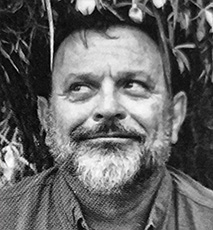ON: Among your various publications, the book Orquídeas Nativas de Florianópolis stands out for its content. Could you talk a little about him?
MN: It's an inventory of species from the point of view of a geographer/botanist. Several authors participated in its elaboration: Eliane Veras da Veiga, Gabriel Stroisc da Costa, Leonardo Ramos Seixas Guimarães. It was conceived in several chapters presenting a brief history about Florianópolis and its nature. It also discusses the passage of naturalists and botanists through Santa Catarina and specifically about Florianópolis, the legal and regulatory frameworks for biodiversity and the Orchidaceae Family, morphology and botanical structure of orchids, about the private Biological collection Orquidário Amélia Cirimbeli Brillinger, about Laelia purpurata and its varieties, as well as a glossary of botanical terms and, of course, the species and genera of ochids native to Florianópolis. The book is in its second revised and expanded edition, has 476 pages, 35 scientific (botanical) illustrations, in color, and more than 560 photos. It comprises 97 genera and 287 taxa, 285 species and two natural hybrids. Of these, 210 (73.2%) are epiphytes, 58 (20.2%) terrestrial, 17 (5.9%) rupicolous and two hemiepiphytes (0.7%), occurring in different phytophysiognomies. It was considered the best graphic product produced in Santa Catarina in 2019, in the category of illustrated/technical/scientific books, received the special diploma of merit from the Academia Catarinense de Letras and the José Vieira da Rosa Geography Award.
ON: Trained geographer, how did this change of course occur? What led you to start studying orchids and become a botanist?
|

|
MN: Yes, I have a Bachelor's Degree in Geography from the Federal University of Santa Catarina and I am a surveying technician at the Federal Technical School of Santa Catarina – ETFSC, now IFSC. The surveyor is a professional who lives in the countryside, literally in the woods, opening trails, mapping and measuring land or installing subdivisions, railways, local roads, federal and state highways. And in Brazil, where we have bush, we will definitely have orchids. I practiced this profession for three years, but I cannot say that this was my first contact with orchids. It's much earlier, it starts still as a child, between 8 and 10 years old, in the place where I was born. On a well-known hill on the outskirts of the urban center of Florianópolis - Morro do Tico - Tico. On this hill, I could see, appreciate and have my first contacts with orchids, because, in a way, I accompanied the men from the center of the city, who "climbed" up the hill to hunt orchids and at that time it was pure fun and we still earned some change for carrying bags of strain full of orchids taken from those forests, with Laelia purpurata and Cattleya intermedia already present.
The Cattleya intermedia they called the dog's ear and the purpurata the parasites.
My second contact with orchids was when I was 14 years old, when I was part of a group of young people at the Metropolitan Cathedral of Florianópolis, and I became friends with young people from the same family (Nereu and Francisco). The father of these young people, Prof. Nereu do Vale Pereira, a well-known figure in the city and with great respectability, was a professor at the Federal University of Santa Catarina, had an orchid house and some books about orchids in his vast library, in a beach house, in Ribeirão da Ilha, a district of Municipality of Florianópolis.
With friendship established with this family, I started to “spend” the weekends at Prof. Nereus. As he already had a certain interest in flowers and especially in orchids, I started to accompany him when he was in his nursery and there, possibly, was born the passion, love and desire to know more deeply about orchids.
The orchidist Marcelo was born.
When I applied for the entrance exam at UFSC, three courses fascinated me and kept my interest: Geography, Biology and Agronomy. I believe that any of the three options would somehow take me to the world of orchids. The choice of the Geography course was due to the Surveying course and because it is a profession that trains a generalist in the most diverse subjects, including botany and biogeography. The years of my graduation went by, I took a competitive exam for the Municipality of Florianópolis, for a geographer, I was approved in first place and started my activities in the Environmental Advisory Board, which years later would become the Municipal Environment Foundation – Floram.
There I was again in front of my passion: orchids.
Established economically and forming a family, the time would come to create my own orchid house (Orquidário Nossa Senhora do Desterro), a collection of collections of Brazilian orchid genus and species, with a purely scientific purpose and not for commercial purposes.
As a Geographer, despite being a “generalist”, I always wanted to seek more information and deepen my knowledge of the Orchidaceae family. Therefore, in the last 30 years I have been acquiring books about this botanical family and today I can say that I must have the largest and most important private library about the Orchidaceae family, today there are 1,456 books.
Also to deepen my scientific knowledge, I did a postgraduate course at UFLA-MG, the course was Botany of Ornamental Plants – My thesis was “The Family Orchidaceae as Ilha do Campeche” which resulted in a book that is out of print.
The Orchidologist Marcelo was born.
ON: This book is an important work for the knowledge of the Brazilian Orchidaceae family, from Santa Catarina, especially for the city of Florianópolis and, consequently, for the state of Santa Catarina. It's a very complete job for a given location, in a more restricted area.
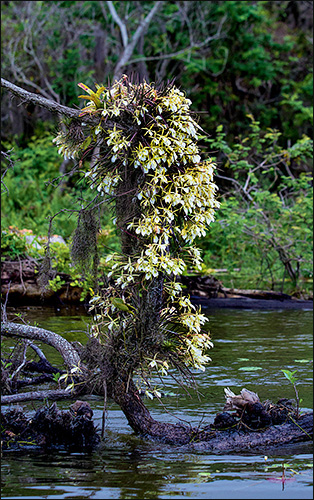 Lagoa de Peri
Lagoa de Peri |
MN: Yes, we are aware that the book “Orquídeas Nativas de Florianópolis” is a complex and extremely complete work for an area, which we can say “restricted”, because it is a municipality located completely within the Atlantic Forest (or what remains of it ), but also because this territory was studied being located on an island (98%) "The Island of Santa Catarin" which I consider as the southern limit for hundreds of species, both terrestrial and aquatic.
On this subject, I take the liberty of transcribing what the Architect and Urban Planner José Tabacow – Roberto Burle Marx's direct assistant, commented on his social network, about our book.
“I am very proud to have the main works on orchids published here in Brazil, as well as two or three books on Venezuelan and Argentinean orchids. To this, came to be joined now “Orquídeas Nativas de Florianópolis” by Marcelo Nascimento. I have no qualms about classifying this last acquisition as the most important, due to its extensive taxonomic, ecological and geography information. It was really a pleasant and unexpected surprise to leaf through this book that I include in that “work of breath” classification. I'll explain it's “unexpected”: Deceived by the title, I imagined it was a work with a more cataloging sense and restricted to the small territory of the Island of Santa Catarina. Thus, although the author has remained faithful to the title, he was not content with merely indicating places of occurrence of the species on the island. A trained geographer, he sought out precise information about the dispersion of each species included, throughout the entire Brazilian territory and even beyond. Now, as the Island of Santa Catarina, although already south of the intertropical belt, marks the end of the tropicality that until now extends due to the northeastern current, the book ends up having a scope that extends almost throughout the entire Atlantic forest and more, by some interiorized biomes, in other cases by the American continent itself. It is, therefore, a work about American orchids in general, which also occur on the Island of Santa Catarina. Thus, we have available a more complete work, abundantly illustrated and mandatory on the shelf of those interested in this family, so tropical, so numerous, so beautiful”.
José Tabacow – April 2021. |
ON: How many years of research were there?
The work had already been done by me for over 8 years.
I started with a large bibliographic research on orchids in Florianópolis, in the Greater Florianópolis region, in Santa Catarina and in Brazil.
I also personally or remotely visited all the Botanical Gardens (Brazilian and foreign), which could have information and/or deposits of orchid exsiccates from Santa Catarina, as well as researches were carried out in national or foreign herbaria with the same objective.
From these consultations, revisions of the nomenclature of the names of genus and species, we created a database gathering the information obtained.
After all verifications and conferences, we obtained 87 genera and 114 orchids that had already been studied in some way and/or collected and deposited in Herbariums.
With this first list of 114 orchids, I started the field work, still on an individual basis (I had not constituted the technical/scientific team whose work would be the result of this book).
|
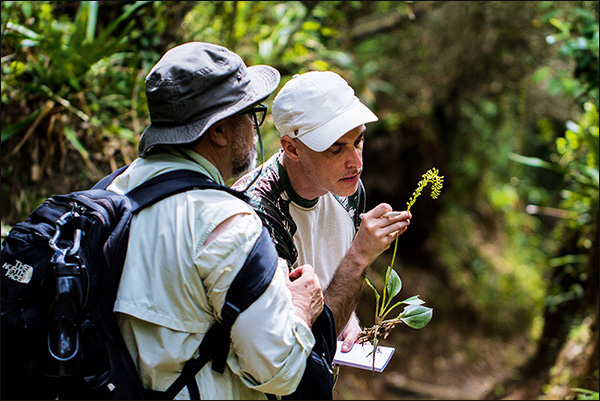 |
My first concern was to locate where these orchids were or could be found, photographing both the habitat and the species (complete plant and flowers), as well as collecting to carry out exsiccates and collections (extremely restrictive), so that they could be cultivated in the orchid house "Coleção Biológica Particular", created with authorization from IBAMA and ICmBio.
With each field expedition, we found new species that were not cataloged in the initial list.
The work gained weight and for me a lot of importance, with regard to the number of species that were not cataloged and/or registered. At that time, I understood that to continue the work I should seek financial assistance in public notices focused on culture. I elaborated the project "Orchids Natives of Florianópolis" and presented it in the Culture Incentive Law of the Municipality of Florianópolis, it was approved unanimously and I received authorization to raise funds to carry out the same, through donations from companies and individuals, established in Florianópolis, through tax waiver for ISS and/or IPTU taxes. Thus, I was able to set up the technical/scientific team to prepare the book
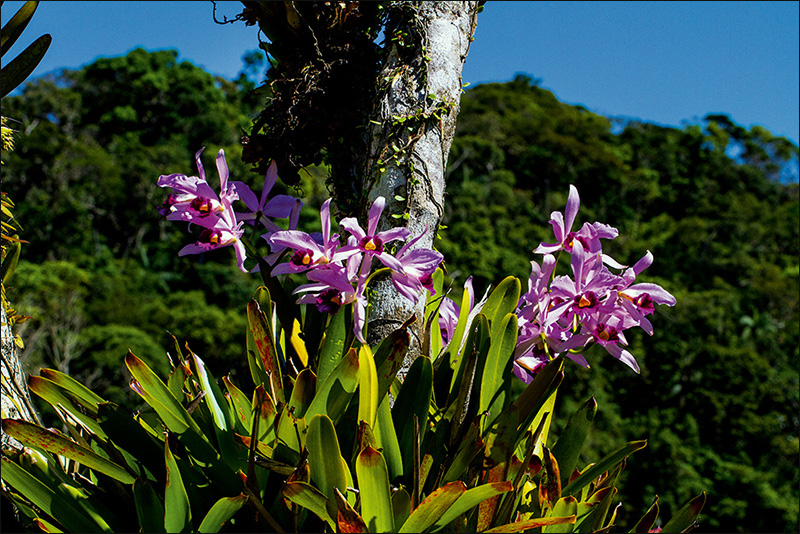
Laelia purpurata
ON: How was this project planned and carried out?
MN: We can divide the book into two stages of realization: during the first 8 years, it was an individual work done by myself.
The remaining two years, a joint work with the technical/scientific team, totaling 10 years.
ON: An infinite number of field trips?
 |
The field expeditions were essential to compose the phytogeographic environment of the book and the encounter with the native orchids of Florianópolis. In the first 8 years, more than 80 field expeditions were carried out throughout the municipal area, including the small territorial area of the municipality on the continent. The concentration of these expeditions for the most part took place within Federal, State and Municipal conservation units that existed within the territory of the Municipality of Florianópolis because these are the areas that have not yet suffered an anthropic action. With the technical/scientific team assembled, over 2 years, we carried out over 43 field expeditions, always with the same objective: finding, photographing, collecting, (as far as possible) to make exsiccates and take them to the orchid house, cultivate them and wait for their flowering to identify the species. The vast majority of species were found flowering with a good population, we made exsiccates that were deposited in the Herbarium of the Botanical Garden of São José - SC. Totaling 435 deposited exsiccates.
ON: Was there a record of new occurrences for the Municipality?
When we started the work (individual), we had 87 genera and 114 species of orchids that had already been in some way studied and/or collected and deposited in Herbariums.
With the publication of the book, we now have 97 genera and 287 taxa, 285 species and two natural hybrids. Of these 210 (73.2%) are epiphytes, 58 (20.2%) terrestrial, 17 (5.9%) rupicolous and two hemiepiphytes (0.7%), occurring in different phytophysiognomies.
The genus with the highest number of species is Acianthera Scheidw, (29), followed by Epidendrum L. (19) Anatlhalis Barb. Rodr. (14), Habenaria Willd. (12), Pabstiella Brieger&Senghas (11) and Octomeria R. Br. (10). In contrast, 49 genera were represented by a single species. In addition, 40 species of unprecedented occurrence were collected in the city of Florianópolis, seven of which were not previously registered in the state of Santa Catarina. 135 species (and the two natural hybrids) recorded for Florianópolis are endemic to Brazil and 95% of them are also considered endemic to the Atlantic Forest.
|
ON: Did you find any non-described species? Any species that had been considered extinct locally or species threatened with extinction?
We found 4 species that are still being studied to know if they are new species or new varieties. They are of the genus Acianthera. 14 species registered in Florianópolis are cited as threatened in three categories: Vulnerable (VU), Endangered (En) and Critically Endangered (CR).
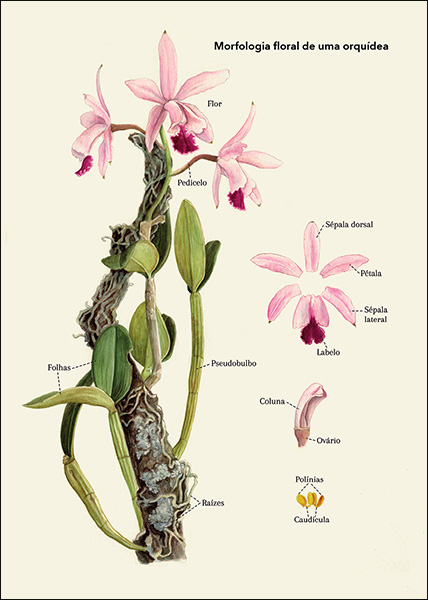 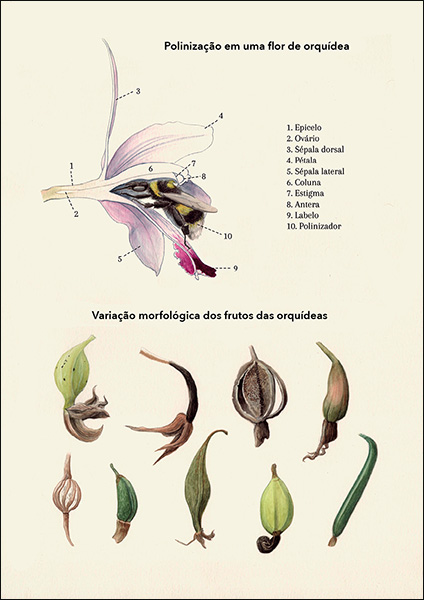
ON: The book has botanical photos and illustrations, including the beautiful cover work. Could you talk a little about how the work was and also a little about these illustrators?
I always had a dream of making a book of this nature, but also that it could link the 19th century and the 21st century. And this connection for me would be through scientific illustrations (in this case botanical).
We had limited financial resources, but at the same time had an orchid (Laelia purpurata), extremely unique and special to us of Santa Catarina. For her dedicated chapter of the book: purpurata Laelia, The Queen of Brazil orchids, this chapter can know their true history in the world botany and his quest to become the flower symbol of Santa Catarina and Florianopolis and its variety Sanguine a Flower Symbol of HEMOSC – Blood Center of Santa Catarina.
The other chapter is dedicated to the horticultural varieties of Laelia purpurata, both in the category – Varieties of Colored Flower (14 varieties) and in the category Varieties of color shape (13 varieties).
In Florianopolis, installed in the neighborhood of the Trinity, the artistic collective Nacasa, illustrators on the coordination of Leandro Lopes, working in an environment of mutual exchanges, some newcomers and other course participants for over 10 years.
I met Leandro and Coletivo Nacasa, through my daughter Julia Staedele Nascimento, who had been a student for some time, and I proposed that botanical illustrations be made of the horticultural varieties Laelia purpurata.
And so the book Orquídeas Nativas de Florianópolis gained its “Artistic” and unique chapter.
| Adriana Rodrigues | Júlia Staedele | Maria Inés Castiñeira | Ana D'Almeida | Julia Sardinha | Alexandre Viana | Simona Ivone | Leandro Lopes |
ON: You won't stop, we know that, what's the next step? More research in progress?
MN: Yes. At the moment, I'm working on the publication of the book “Fritz Müller – Desterro (1822-1897)” scheduled for release in June/July 2022, which aims to be the biggest and best biography about him. Many, many documents that were “lost” in the bureaucracy and in the basements of our institutions for over 150 years are being found.
The story of this scientist is, unfortunately, little known and disseminated not only in Brazil but throughout the world, except for Germany and in the book “Orquídeas Nativas de Florianópolis”, he is honored in the chapter dedicated to Naturalists and Botanists who were in Florianópolis and in Santa Catarina.
In his entire life, Fritz Muller published 264 works in the most renowned scientific journals of the 19th century, in addition to the book “Fur Darwin”. “In Favor of Darwin” being the first book that discussed Darwin's theories, not with new theories, but in the practical field of Science.
Darwin had access to Fritz Müller's book and from then on became friends (although they never met) through letters. There were more than 90 cards exchanged between them.
As a Traveling Naturalist at the National Museum of Rio de Janeiro, where in addition to sending collections of insects and plants, he published 13 scientific articles.
Having published this book, we already have the project pre-approved in some Brazilian institutions to publish the books “Orquídeas Nativas de Santa Catarina” and “Bromelias Nativas de Santa Catarina”.
Marcelo Vieira Nascimento
mar@floripa.com.br
55(48) 999145928.
|
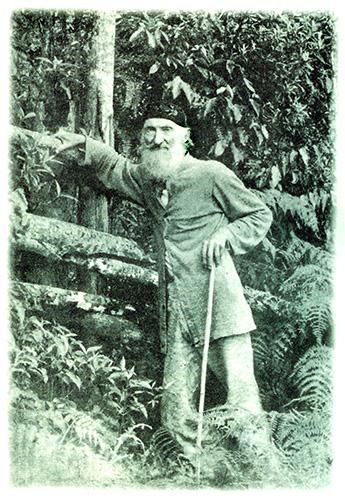 |
|
![]()
